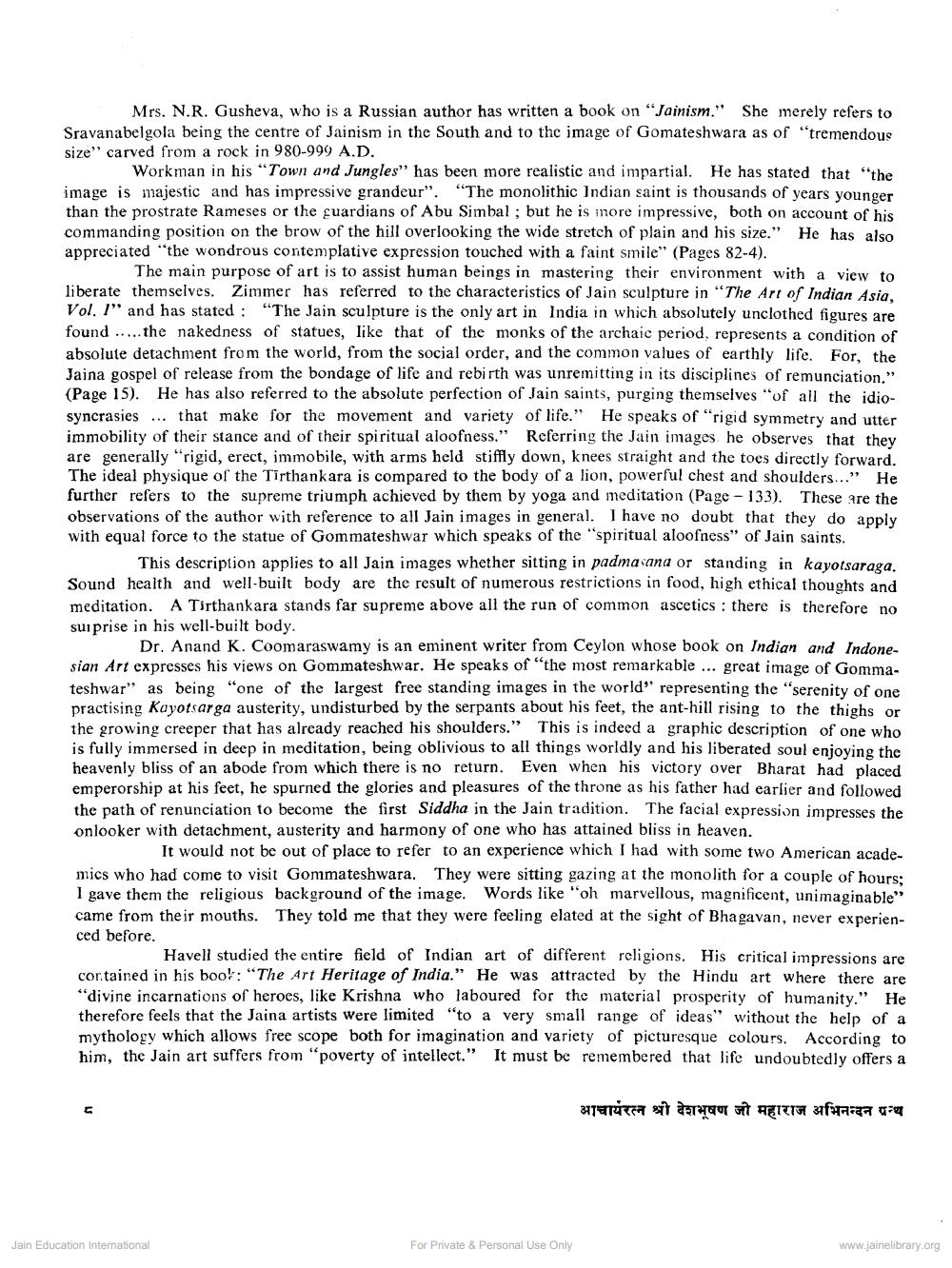________________
Mrs. N.R. Gusheva, who is a Russian author has written a book on "Jainism." She merely refers to Sravanabelgola being the centre of Jainism in the South and to the image of Gomateshwara as of "tremendous size" carved from a rock in 980-999 A.D.
Workman in his "Town and Jungles" has been more realistic and impartial. He has stated that "the image is majestic and has impressive grandeur". "The monolithic Indian saint is thousands of years younger than the prostrate Rameses or the guardians of Abu Simbal; but he is more impressive, both on account of his commanding position on the brow of the hill overlooking the wide stretch of plain and his size." He has also appreciated "the wondrous contemplative expression touched with a faint smile" (Pages 82-4).
The main purpose of art is to assist human beings in mastering their environment with a view to liberate themselves. Zimmer has referred to the characteristics of Jain sculpture in "The Art of Indian Asia, Vol. 1" and has stated: "The Jain sculpture is the only art in India in which absolutely unclothed figures are found.....the nakedness of statues, like that of the monks of the archaic period, represents a condition of absolute detachment from the world, from the social order, and the common values of earthly life. For, the Jaina gospel of release from the bondage of life and rebirth was unremitting in its disciplines of remunciation." (Page 15). He has also referred to the absolute perfection of Jain saints, purging themselves "of all the idiosyncrasies... that make for the movement and variety of life." He speaks of "rigid symmetry and utter immobility of their stance and of their spiritual aloofness." Referring the Jain images he observes that they are generally "rigid, erect, immobile, with arms held stiffly down, knees straight and the toes directly forward. The ideal physique of the Tirthankara is compared to the body of a lion, powerful chest and shoulders..." He further refers to the supreme triumph achieved by them by yoga and meditation (Page - 133). These are the observations of the author with reference to all Jain images in general. I have no doubt that they do apply with equal force to the statue of Gommateshwar which speaks of the "spiritual aloofness" of Jain saints.
This description applies to all Jain images whether sitting in padmasana or standing in kayotsaraga. Sound health and well-built body are the result of numerous restrictions in food, high ethical thoughts and meditation. A Tirthankara stands far supreme above all the run of common ascetics: there is therefore no surprise in his well-built body.
Dr. Anand K. Coomaraswamy is an eminent writer from Ceylon whose book on Indian and Indonesian Art expresses his views on Gommateshwar. He speaks of "the most remarkable ... great image of Gommateshwar" as being "one of the largest free standing images in the world" representing the "serenity of one practising Kayotsarga austerity, undisturbed by the serpants about his feet, the ant-hill rising to the thighs or the growing creeper that has already reached his shoulders." This is indeed a graphic description of one who is fully immersed in deep in meditation, being oblivious to all things worldly and his liberated soul enjoying the heavenly bliss of an abode from which there is no return. Even when his victory over Bharat had placed emperorship at his feet, he spurned the glories and pleasures of the throne as his father had earlier and followed the path of renunciation to become the first Siddha in the Jain tradition. The facial expression impresses the onlooker with detachment, austerity and harmony of one who has attained bliss in heaven.
It would not be out of place to refer to an experience which I had with some two American academics who had come to visit Gommateshwara. They were sitting gazing at the monolith for a couple of hours; I gave them the religious background of the image. Words like "oh marvellous, magnificent, unimaginable" came from their mouths. They told me that they were feeling elated at the sight of Bhagavan, never experienced before.
Havell studied the entire field of Indian art of different religions. His critical impressions are contained in his book: "The Art Heritage of India." He was attracted by the Hindu art where there are "divine incarnations of heroes, like Krishna who laboured for the material prosperity of humanity." He therefore feels that the Jaina artists were limited "to a very small range of ideas" without the help of a mythology which allows free scope both for imagination and variety of picturesque colours. According to him, the Jain art suffers from "poverty of intellect." It must be remembered that life undoubtedly offers a
आचार्यरत्न श्री देशभूषण जी महाराज अभिनन्दन ग्रन्थ
C
Jain Education International
For Private & Personal Use Only
www.jainelibrary.org




